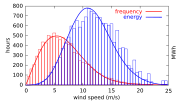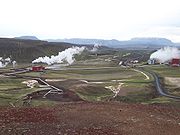 Renewable energy (or green energy) is energy from renewable natural resources that are replenished on a human timescale. The most widely used renewable energy types are solar energy, wind power and hydropower. Bioenergy and geothermal power are also significant in some countries. Some also consider nuclear power a renewable power source, although this is controversial. Renewable energy installations can be large or small and are suited for both urban and rural areas. Renewable energy is often deployed together with further electrification. This has several benefits: electricity can move heat and vehicles efficiently, and is clean at the point of consumption. Variable renewable energy sources are those that have a fluctuating nature, such as wind power and solar power. In contrast, controllable renewable energy sources include dammed hydroelectricity, bioenergy, or geothermal power. Renewable energy systems have rapidly become more efficient and cheaper over the past 30 years. A large majority of worldwide newly installed electricity capacity is now renewable. Renewable energy sources, such as solar and wind power, have seen significant cost reductions over the past decade, making them more competitive with traditional fossil fuels. In most countries, photovoltaic solar or onshore wind are the cheapest new-build electricity. From 2011 to 2021, renewable energy grew from 20% to 28% of global electricity supply. Power from sun and wind accounted for most of this increase, growing from a combined 2% to 10%. Use of fossil energy shrank from 68% to 62%. In 2022, renewables accounted for 30% of global electricity generation, and are projected to reach over 42% by 2028. Many countries already have renewables contributing more than 20% of their total energy supply, with some generating over half or even all their electricity from renewable sources. The main motivation to replace fossil fuels with renewable energy sources is to slow and eventually stop climate change, which is widely agreed to be caused mostly by greenhouse gas emissions. In general, renewable energy sources cause much lower emissions than fossil fuels. The International Energy Agency estimates that to achieve net zero emissions by 2050, 90% of global electricity generation will need to be produced from renewable sources. Renewables also cause much less air pollution than fossil fuels, improving public health, and are less noisy. The deployment of renewable energy still faces obstacles, especially fossil fuel subsidies, lobbying by incumbent power providers, and local opposition to the use of land for renewables installations. Like all mining, the extraction of minerals required for many renewable energy technologies also results in environmental damage. In addition, although most renewable energy sources are sustainable, some are not. For example, some biomass sources are unsustainable at current rates of exploitation. (Full article...)  India is the world's 4th largest consumer of electricity and the world's 3rd largest renewable energy producer with 40% of energy capacity installed in the year 2022 (160 GW of 400 GW) coming from renewable sources. Ernst & Young's (EY) 2021 Renewable Energy Country Attractiveness Index (RECAI) ranked India 3rd behind USA and China. In FY2023-24, India is planning to issue 50 GW tenders for wind, solar and hybrid projects. India has committed for a goal of 500 GW renewable energy capacity by 2030. In line with this commitment, India's installed renewable energy capacity has been experiencing a steady upward trend. From 94.4 GW in 2021, the capacity has gone up to 119.1 GW in 2023 as of Q4. In 2016, Paris Agreement's Intended Nationally Determined Contributions targets, India made commitment of producing 50% of its total electricity from non-fossil fuel sources by 2030. In 2018, India's Central Electricity Authority set a target of producing 50% of the total electricity from non-fossil fuels sources by 2030. India has also set a target of producing 175 GW by 2022 and 500 GW by 2030 from renewable energy. As of September 2020, 89.22 GW solar energy is already operational, projects of 48.21 GW are at various stages of implementation and projects of 25.64 GW capacity are under various stages of bidding. In 2020, 3 of the world's top 5 largest solar parks were in India including world's largest 2255 MW Bhadla Solar Park in Rajasthan and world's second-largest solar park of 2000 MW Pavgada Solar Park Tumkur in Karnataka and 1000 MW Kurnool in Andhra Pradesh. Wind power in India has a strong manufacturing base with 20 manufactures of 53 different wind turbine models of international quality up to 3 MW in size with exports to Europe, United States and other countries. (Full article...)
– International Energy Agency, Renewable energy... into the mainstream, 2002. Renewable energy sourcesGeneralRenewable energy commercialization · Smart grid · Timeline of sustainable energy research 2020–present Renewable energy by countryList of countries by electricity production from renewable sources
WikiProjects connected with renewable energy: Jeremy Leggett is a British social entrepreneur and writer. He founded and was a board director of Solarcentury from 1997 to 2020, an international solar solutions company, and founded and was chair of SolarAid, a charity funded with 5% of Solarcentury's annual profits that helps solar-lighting entrepreneurs get started in Africa (2006–2020). SolarAid owns a retail brand SunnyMoney that was for a time Africa's top-seller of solar lighting, having sold well over a million solar lights, all profits recycled to the cause of eradicating the kerosene lantern from Africa. Leggett is winner of the first Hillary Laureate for International Leadership in Climate Change (2009), a Gothenburg Prize (2015), the first non-Dutch winner of a Royal Dutch Honorary Sustainability Award (2016), and has been described in the Observer as "Britain’s most respected green energy boss." He is the author of five books: "The Winning of The Carbon War", an account of what he sees as the "turnaround years" in the dawn of the global energy transition, 2013–2015, with an update edition spanning 2016–2017, "The Energy of Nations" (2013), "The Solar Century" (2009), "Half Gone" (2005) and "The Carbon War" (2000). He continues to write on his blog, and in occasional articles for national media. He lectured on short courses in business and society at the Universities of Cambridge (UK) and St Gallen (Switzerland). His vision is of a renaissance in civilisation aided or even triggered by renewable energy and its intrinsic social benefits. (Full article...)... that the Ontario Sustainable Energy Association (OSEA) is a non-profit organization supporting the growth of renewable energy and Community Power projects in the Canadian Province of Ontario? OSEA advocated an advanced renewable energy Feed-in Tariff program for Ontario, resulting in the creation of the Renewable Energy Standard Offer Program, a precursor to the Green Energy Act and, in 2007, the most progressive energy policy in North America in a decade. OSEA has approximately 130 community and industry members as well as individual members. The following are images from various renewable energy-related articles on Wikipedia.
The following Wikimedia Foundation sister projects provide more on this subject:
Discover Wikipedia using portals |




































![Image 35Concentrated solar panels are getting a power boost. Pacific Northwest National Laboratory (PNNL) will be testing a new concentrated solar power system – one that can help natural gas power plants reduce their fuel usage by up to 20 percent.[needs update] (from Solar energy)](http://upload.wikimedia.org/wikipedia/commons/thumb/8/82/Photo_of_the_Week-_Boosting_Solar_Technology_%288722948189%29.jpg/180px-Photo_of_the_Week-_Boosting_Solar_Technology_%288722948189%29.jpg)













































